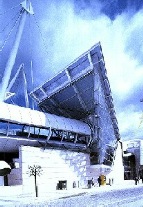|
1 2 |
 Copyright: Luiz Trigueiros und Claudio Sat: Architecture. Lisbon Expo'98. Lissabon, 1998, S.189 |
Expo ’98 was to feature no independent country pavilions. Instead, the foreign exhibitors were placed in the large exhibition halls to the north and south. The four 10,000 m ² halls in the northern part were placed one behind another at a distance of 25 metres. These accommodated 54 nations. By using space frame roofing elements of differing heights, the architects aimed to represent the wave movement of water and to give a more dynamic appearance to the gigantic boxes. In one of the buildings in the southern area, the architects created a post office, banks, a medical centre, and administrative and conference rooms with a view to the subsequent use of the halls by Lisbon’s trade fair centre. From there, a travelator gave visitors more rapid access to the exhibitions. The southern halls, designed by Manual Salgado, whose ground plan was structured around paths and squares, covered 50,000 square metres for 43 nations. A temporary construction, they were to be replaced by residential buildings after the exhibition.
Most of the participating nations tried to establish a link between their exhibits and the theme of the world exposition – the oceans. The proposals and ideas ranged from the “interactive dolphinarium” – a gigantic, three-dimensional computer game in which visitors were able to call up various dolphin noises in front of a giant screen – to Russia’s suggestion of placing an iceberg in the Tagus estuary, which had to be abandoned for financial reasons. Most of the exhibitions used new audio-visual and computer-aided media to simulate novel sensory experiences by means of technological tricks. Stylistically, the images produced by the installations fell somewhere between the video art of the 1980s and the aesthetics of computer games. Video projections above and beneath the surface of the water, combinations of real objects, such as boats, with computer simulations, or a 3D cinema experience in "artificial" rain took onlookers into decorative underwater worlds, scientific environments or on sea voyages. The light-hearted treatment of the theme was also evident in various design aspects of the grounds themselves, such as the numerous fountains or the wave-shaped seats along the main “Water Way” promenade.
In the German pavilion in the northern section, a computer simulation on 1,620 square metres of floor space had visitors dive down to the Oceanis marine research station at a depth of 100 metres. The cry of seagulls and the noise of wind and water at the start of the journey gradually gave way to the increasingly muffled hum of engines and to shoals of fish swimming past the windows. Down at the bottom, a tunnel led them to the “Marine Archive”, with information on environmental issues along Germany’s coasts, environmental protection on the high seas, climate and polar research, and ways of monitoring navigation. Visitors could also be transported across a virtual sea on a research ship. The technical section showed examples of industrial uses of marine resources, presenting oil skimming techniques, chemicals tankers and luxurious cruisers. With the visitors back on board, the Expo Jet then travelled back up to the surface, took off and raced through space and time to land at Expo 2000 in Hannover.
| Year: 1998 | City: Lisbon | Country: Portugal |
| Duration: 22nd May - 30th September 1998 | ||